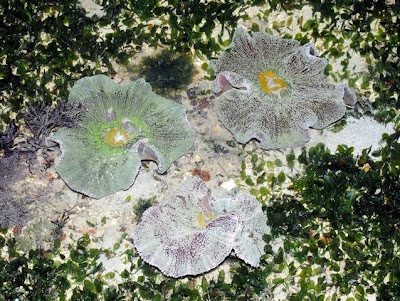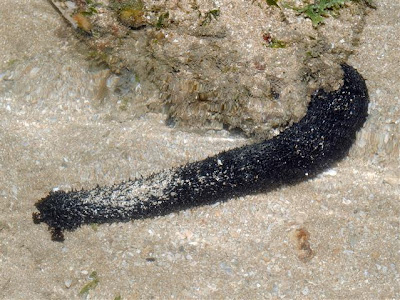We are back at Chek Jawa on a predawn survey and focused on the coral rubble near the Chek Jawa front beacon. We were here last month but the tide was not low enough to document what lies out there.
The tide went out extensively and we were able to survey the coral rubble beyond the beacon itself. So how is this fragile but also richest stretch of Chek Jawa shore doing?
There were quite a number of colourful sponges at the coral rubble but it was just a glimpse of how colourful and thick the marine life was before the mass mortality event in 2007.
Unfortunately, I have never visited Chek Jawa before the mass death. In fact my first visit to Chek Jawa was when we witnessed the mortality event. :(
From Ria's old photo taken in 2002, you can see that whole coral rubble was covered with thick growths of colourful sponges and other marine organisms.
However, a shot of the beacon area on this trip reveals that the current status is still only a shadow of the glorious past. But recovery is STILL taking place and it is doing so slowly and probably may change into a habitat that is not exactly the same as in the past. Whether it is for better or for worse, time will tell.
I was searching high and low for the Knobbly sea stars (Protoreaster nodosus) and was relieved to find two of them near the front beacon.
Finding these two knobblies is significant for an echinoderm lover like me and makes me believe that marine life is still hanging on tightly on this shore.
A lovely sight on this trip would be these small growths of the Barrel sponges (Xestospongia testudinaria) which were also found in the 2002 photo at the bottom left hand corner. I do hope that many of these will proliferate and grow into larger ones in the future.
Certain stretches of the coral rubble can be quite colourful as they are covered with lots of encrusting sponges, corallimorphs, ascidians, zoanthids and algae.
There are also many Posy sea anemones like what we would find on Pulau Sekudu, which is a stone's throw away.
There are also quite a number of Sea fans or Gorgonians (Order Gorgonacea). Though many of them are yellow and branching, I also came across a short and highly branched pink version and also two of them that are probably Sea whips.
This sea fan has something stuck onto the branches and it seems to be sponges and hydroids.
The seagrass shore near the coral rubble is filled with plenty of Haddon's carpet anemones (Stichodactyla haddoni)!
A purple Haddon's carpet anemone has three of the Kite butterflyfish (Parachaetodon ocellatus) swimming near the tentacles.
As for this carpet anemone, the colour looks slightly brighter than the common ones that we find on our shores.
These carpet anemones are also found in good numbers at the coral rubble and they are sometimes found together with sponges and soft corals like what you see in this photo.
Not observed previously at Chek Jawa, there are many of these Spiky flowery soft corals (Stereonephthya sp.) that are commonly found on Tuas.
They are found in different colours such as yellow, orange, blue and sometimes in pink.
There are also a few Pink flowery soft corals (Family Nephtheidae) at the coral rubble.
And if you were to pay a closer look at the tentacles, you would realize that there are commensals such as Tiny colourful brittle stars (Ophiothela danae) that live on these soft corals.
Also another type of soft coral, I only saw one Ball flowery soft coral though. It has a commensal snapping shrimp that I didn't notice until I processed the photos back at home.
A good sign of recovery would be many small and medium-sized colonies of the boulder-shaped Pore hard corals (Porites sp.).
There was even a Carpet eel blenny (Congrogadus subducens) lurking inside the crevice of the hard coral!
I also came across a dark green version of the Pore hard coral which is quite large as compared to the others on the coral rubble.
The polyps of these types of hard corals are very small and these also explains for the short tentacles that stick out like star-like structures.
I'm not too sure what this colony of hard coral is.... could it also be the pore hard coral? Or is it the Neat hexa corals (Pseudosiderastrea tayami)?
I also saw the Boulder sandpaper coral (Psammocora sp.) on the edge of the coral rubble. This colony is quite large!
There was another one that was found beside a carpet anemone. Though the splashy waves made it hard to photograph, it was a relief that the waters are quite clear when the tide was at its minimum.
There are small clumps of the Tape seagrass (Enhalus acoroides) at the deeper ends though the blades have been "chomped off". The tape seagrass is seldom seen on Chek Jawa.
Lots of echinoderm reside on the shores of Chek Jawa such as this six-armed version of the Eight-armed sand star (Luidia maculata).
There were also two of the blue and black Feather stars (Order Comatulida) which looks elegant when their arms are extended outwards.
Though sighted at Sekudu a few times on previous trips, this is my first sighting of the Long black sea cucumber (Holothuria leucospilota) on Chek Jawa. These sea cucumbers are very commonly found on rocky shores of the South.
Ria shared with me her find of this Synaptic sea cucumber that was found coiled around the yellow sponges. Apparently, she saw quite a number of them which I was oblivious of their presence when documenting the coral rubble.
We also took time to look at what lies underneath the House Number 1 jetty on a super low spring tide. This is a first time for me and I was glad to see colourful encrustations and branching sponges! There were many Biscuit stars (Goniodiscaster scaber) and sea fans as well!
A special find underneath the jetty would be this pretty Purple-spotted yellow flatworm (Pseudoceros laingensis).
The shores of Chek Jawa are still very much alive and sometimes all we need to do is to sacrifice our sleep to survey the shore at super low spring tides which normally take place at super unearthly hours. This trip started near 4am!
Thank you Nparks for giving us the permission to visit the shore. Chek Jawa Wetlands is out of bounds to visitors going down but we can still visit this precious location through the boardwalks.
































